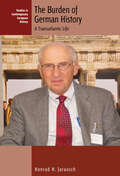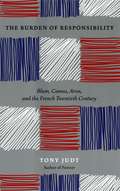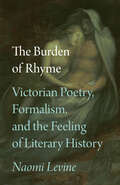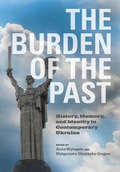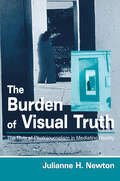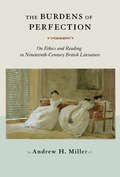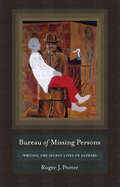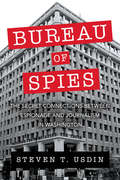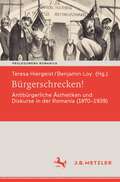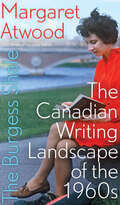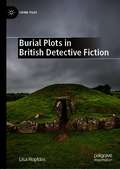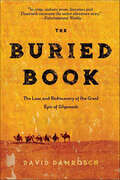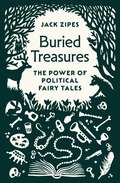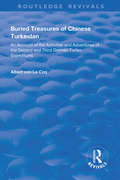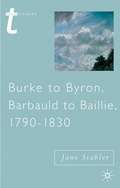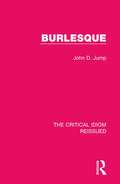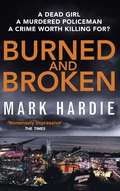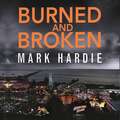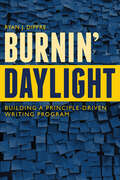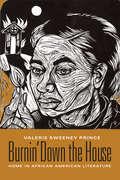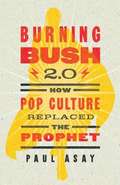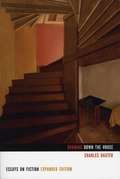- Table View
- List View
The Burden of German History: A Transatlantic Life (Studies in Contemporary European History #28)
by Konrad H. JarauschAs one of the leading historians of Modern Europe and an internationally acclaimed scholar for the past five decades, Konrad H. Jarausch presents a sustained academic reflection on the post-war German effort to cope with the guilt of the Holocaust amongst a generation of scholars too young to have been perpetrators. Ranging from his war-time childhood to Americanization as a foreign student, from his development as a professional historian to his directorship of the Zentrum für Zeithistorische Forschung and concluding with his mentorship of dozens of PhDs, The Burden of Germany History reflects on the emergence of a self-critical historiography of a twentieth-century Germany that was wrestling with the responsibility for war and genocide. This partly professional and partly personal autobiography explores a wide range of topics including the development of German historiography and its methodological debates, the interdisciplinary teaching efforts in German studies, and the role of scholarly organizations and institutions.
The Burden of Responsibility: Blum, Camus, Aron, and the French Twentieth Century
by Tony JudtUsing the lives of the three outstanding French intellectuals of the twentieth century, renowned historian Tony Judt offers a unique look at how intellectuals can ignore political pressures and demonstrate a heroic commitment to personal integrity and moral responsibility unfettered by the difficult political exigencies of their time. Through the prism of the lives of Leon Blum, Albert Camus, and Raymond Aron, Judt examines pivotal issues in the history of contemporary French society—antisemitism and the dilemma of Jewish identity, political and moral idealism in public life, the Marxist moment in French thought, the traumas of decolonization, the disaffection of the intelligentsia, and the insidious quarrels rending Right and Left. Judt focuses particularly on Blum's leadership of the Popular Front and his stern defiance of the Vichy governments, on Camus's part in the Resistance and Algerian War, and on Aron's cultural commentary and opposition to the facile acceptance by many French intellectuals of communism's utopian promise. Severely maligned by powerful critics and rivals, each of these exemplary figures stood fast in their principles and eventually won some measure of personal and public redemption. Judt constructs a compelling portrait of modern French intellectual life and politics. He challenges the conventional account of the role of intellectuals precisely because they mattered in France, because they could shape public opinion and influence policy. In Blum, Camus, and Aron, Judt finds three very different men who did not simply play the role, but evinced a courage and a responsibility in public life that far outshone their contemporaries. "An eloquent and instructive study of intellectual courage in the face of what the author persuasively describes as intellectual irresponsibility."—Richard Bernstein, New York Times
The Burden of Rhyme: Victorian Poetry, Formalism, and the Feeling of Literary History
by Naomi LevineA major new account of Victorian poetry and its place in the field of literary studies. The Burden of Rhyme shows how the nineteenth-century search for the origin of rhyme shaped the theory and practice of poetry. For Victorians, rhyme was not (as it was for the New Critics, and as it still is for us) a mere technique or ahistorical form. Instead, it carried vivid historical fantasies derived from early studies of world literature. Naomi Levine argues that rhyme’s association with the advent of literary modernity and with a repertoire of medievalist, Italophilic, and orientalist myths about love, loss, and poetic longing made it a sensitive historiographic instrument. Victorian poets used rhyme to theorize both literary history and the most elusive effects of aesthetic form. This Victorian formalism, which insisted on the significance of origins, was a precursor to and a challenge for twentieth-century methods. In uncovering the rich relationship between Victorian poetic forms and a forgotten style of literary-historical thought, The Burden of Rhyme reveals the unacknowledged influence of Victorian poetics—and its repudiation—on the development of modern literary criticism.
The Burden of the Past: History, Memory, and Identity in Contemporary Ukraine
by Anna Wylegała and Małgorzata Głowacka-GrajperEssays on how chaos, totalitarianism, and trauma have shaped Ukraine’s culture: “A milestone of the scholarship about Eastern European politics of memory.” —Wulf Kansteiner, Aarhus UniversityIn a century marked by totalitarian regimes, genocide, mass migrations, and shifting borders, the concept of memory in Eastern Europe is often synonymous with notions of trauma. In Ukraine, memory mechanisms were disrupted by political systems seeking to repress and control the past in order to form new national identities supportive of their own agendas. With the collapse of the Soviet Union, memory in Ukraine was released, creating alternate visions of the past, new national heroes, and new victims. This release of memories led to new conflicts and “memory wars.”How does the past exist in contemporary Ukraine? The works collected in The Burden of the Past focus on commemorative practices, the politics of history, and the way memory influences Ukrainian politics, identity, and culture. The works explore contemporary memory culture in Ukraine and the ways in which it is being researched and understood. Drawing on work from historians, sociologists, anthropologists, psychologists, and political scientists, the collection represents a truly interdisciplinary approach. Taken together, the groundbreaking scholarship collected in The Burden of the Past provides insight into how memories can be warped and abused, and how this abuse can have lasting effects on a country seeking to create a hopeful future.
The Burden of Visual Truth: The Role of Photojournalism in Mediating Reality (Routledge Communication Series)
by Julianne NewtonAs the visual component of contemporary media has overtaken the verbal, visual reportage has established a unique and extremely significant role in 21st-century culture. Julianne Newton has prepared this comprehensive analysis of the development of the role of visual reportage as a critical player in the evolution of our understanding of ourselves, others, and the world. The Burden of Visual Truth offers a first assessment of the role of visual journalism within the context of the complex, cross-disciplinary pool of literature and ideas required for synthesis. Newton approaches the subject matter from several perspectives, examining the theoretical and ideological bases for visual truth, particularly as conveyed by the news media, and applying relevant research on photojournalism and reality imagery to contemporary newspaper, broadcast, and internet professional practice. She extends visual communication theory by proposing an ecology of the visual for 21st century life and developing a typology of human visual behavior. Scholars in visual studies, media studies, journalism, nonverbal communication, cultural history, and psychology will find this analysis invaluable as a comprehensive base for studying reality imaging and human visual behavior. The volume also is appropriate for journalism and media studies coursework at the undergraduate and graduate levels. With its conclusions about the future of visual reportage, The Burden of Visual Truth also will be compelling reading for journalism and mass communication professionals concerned with improving media credibility and maintaining a significant course for journalism in the 21st century. For all who seek to understand the role of visual media in the formation of their views of the world and of their own identities, this volume is a must-read.
The Burdens of Perfection: On Ethics and Reading in Nineteenth-Century British Literature
by Andrew H. MillerLiterary criticism has, in recent decades, rather fled from discussions of moral psychology, and for good reasons, too. Who would not want to flee the hectoring moralism with which it is so easily associated-portentous, pious, humorless? But in protecting us from such fates, our flight has had its costs, as we have lost the concepts needed to recognize and assess much of what distinguished nineteenth-century British literature. That literature was inescapably ethical in orientation, and to proceed as if it were not ignores a large part of what these texts have to offer, and to that degree makes less reasonable the desire to study them, rather than other documents from the period, or from other periods.Such are the intuitions that drive The Burdens of Perfection, a study of moral perfectionism in nineteenth-century British culture. Reading the period's essayists (Mill, Arnold, Carlyle), poets (Browning and Tennyson), and especially its novelists (Austen, Dickens, Eliot, and James), Andrew H. Miller provides an extensive response to Stanley Cavell's contribution to ethics and philosophy of mind. In the process, Miller offers a fresh way to perceive the Victorians and the lingering traces their quests for improvement have left on readers.
Bureau of Missing Persons: Writing the Secret Lives of Fathers
by Roger J. PorterA devoted reader of autobiographies and memoirs, Roger J. Porter has observed in recent years a surprising number of memoirs by adult children whose fathers have led secret lives. Some of the fathers had second families; some had secret religious lives; others have been criminals, liars, or con men. Struck by the intensely human drama of secrecy and deception played out for all to see, Porter explores the phenomenon in great depth. In Bureau of Missing Persons he examines a large number of these works—eighteen in all—placing them in a wide literary and cultural context and considering the ethical quandaries writers face when they reveal secrets so long and closely held. Among the books Porter treats are Paul Auster’s The Invention of Solitude, Alison Bechdel’s graphic memoir Fun Home, Essie Mae Washington-Williams’s Dear Senator (on her father, Strom Thurmond), Bliss Broyard’s One Drop, Mary Gordon’s The Shadow Man, and Geoffrey Wolff’s The Duke of Deception. He also discusses Nathaniel Kahn’s documentary film, My Architect. These narratives inevitably look inward to the writer as well as outward to the parent. The autobiographical children are compelled, if not consumed, by a desire to know. They become detectives, piecing together clues to fill memory voids, assembling material and archival evidence, public and private documents, letters, photographs, and iconic physical objects to track down the parent.
Bureau of Spies: The Secret Connections between Espionage and Journalism in Washington
by Steven T. UsdinBrings to light the long history of spies posing as journalists in Washington.Covert intelligence gathering, propaganda, fake news stories, dirty tricks--these tools of spy craft have been used for seven decades by agents hiding in plain sight in Washington's National Press Building. This revealing book tells the story of espionage conducted by both US and foreign intelligence operatives just blocks from the White House. Journalist Steven T. Usdin details how spies for Nazi Germany, imperial Japan, the Soviet Union, and the CIA have operated from the offices, corridors, and bars of this well-known press center to collect military, political, and commercial secrets.As the author's extensive research shows, efforts to influence American elections by foreign governments are nothing new, and WikiLeaks is not the first antisecrecy group to dump huge quantities of classified data into the public domain. Among other cases, the book documents the work of a journalist who created a secret intelligence organization that reported directly to President Franklin Roosevelt and two generations of Soviet spies who operated undercover as TASS reporters and ran circles around the FBI. The author also reveals the important roles played by journalists in the Cuban missile crisis, and presents information about a spy involved in the Watergate break-in who had earlier spied on Republican presidential candidate Barry Goldwater for then-President Lyndon Johnson.Based on interviews with retired CIA, NSA, FBI, and KGB officers, as well as declassified and leaked intelligence documents, this fascinating historical narrative shows how the worlds of journalism and intelligence sometimes overlap and highlights the ethical quandaries that espionage invariably creates.
Bürgerschrecken!: Antibürgerliche Ästhetiken und Diskurse in der Romania (1870-1939) (Prolegomena Romanica. Beiträge zu den romanischen Kulturen und Literaturen)
by Teresa Hiergeist Benjamin LoyDer Band untersucht ästhetische und diskursive Formen, die in der Moderne an die Kritik des Bürgerlichen geknüpft sind. Der Fokus richtet sich auf Beispiele aus Frankreich, Italien und Spanien sowie aus Lateinamerika. Diese kulturvergleichende Perspektive auf Dimensionen von Antibürgerlichkeit eröffnet neue Lesarten eines zentralen Themas der Moderne. Die Bandbreite der Analysen umfasst die ästhetischen Dimensionen von anarchistischen Reformdiskursen und reaktionären Gesellschaftsentwürfen ebenso wie von Modellen einer christlichen Kapitalismuskritik oder der revolutionären Programme der Avantgarden. Vor dem Hintergrund eines Wiedererstarkens antibürgerlicher Formationen in der Gegenwart bietet der Band eine historisch-kritische Diskussion alternativer Sozialimaginationen jenseits der bürgerlichen Gesellschaft.
The Burgess Shale: The Canadian Writing Landscape of the 1960s (The CLC Kreisel Lecture Series)
by Margaret Atwood“Atwood provides a window into her own early writing days . . . a treasure for readers interested in Canadian literature because this is where it all began.” —Prairie Fire Review of Books“The outburst of cultural energy that took place in the 1960s was in part a product of the two decades that came before. It’s always difficult for young people to see their own time in perspective: when you’re in your teens, a decade earlier feels like ancient history and the present moment seems normal: what exists now is surely what has always existed.”In this short work, Margaret Atwood, author of The Handmaid’s Tale and “Canada’s most famous writer” (The New Yorker), compares the Canadian literary landscape of the 1960s to the Burgess Shale, a geological formation that contains the fossils of many strange prehistoric life forms. The Burgess Shale is not entirely about writing itself, however: Atwood also provides some insight into the meager writing infrastructure of that time, taking a lighthearted look at the early days of the institutions we take for granted today—from writers’ organizations, prizes, and grant programs to book tours and festivals.“Allows the reader a brief glimpse into the mind of a great writer and her perspective and experience living through what would now seem to many the Stone Age of the Canadian writing scene . . . invaluable and very readable.” —Canadian Literature
Burial Plots in British Detective Fiction (Crime Files)
by Lisa HopkinsBurial Plots in British Detective Fiction offers an overview of the ways in which the past is brought back to the surface and influences the present in British detective fiction written between 1920 and 2020. Exploring a range of authors including Agatha Christie, Patricia Wentworth, Val McDermid, Sarah Caudwell, Georgette Heyer, Dorothy Dunnett, Jonathan Stroud and Ben Aaronovitch, Lisa Hopkins argues that both the literal and literary disinterment of the past use elements of the national past to interrogate the present. As such, in the texts discussed, uncovering the truth about an individual crime is also typically an uncovering of a more general connection between the present and the past. Whether detective novels explore murders on archaeological digs, hauntings, cold crimes or killings at Christmas, Hopkins explores the underlying message that you cannot understand the present unless you understand the past.
The Buried Book: The Loss and Rediscovery of the Great Epic of Gilgamesh
by David DamroschA “lively and accessible” history of the ancient Epic of Gilgamesh, and its sensational rediscovery in the nineteenth century (The Boston Sunday Globe).Composed in Middle Babylonia around 1200 BCE, The Epic of Gilgamesh foreshadowed later stories that would become as fundamental as any in human history: the Bible, Homer, The Thousand and One Nights. But in 600 BCE, the clay tablets that bore the story were lost—buried beneath ashes and ruins when the library of the wild king Ashurbanipal was sacked in a raid.The Buried Book begins with the rediscovery of the forgotten epic and its deciphering in 1872 by George Smith, a brilliant self-taught linguist who created a sensation—and controversy—when he discovered Gilgamesh among the thousands of tablets in the British Museum’s collection. From there the story goes backward in time, all the way to Gilgamesh himself. Damrosch reveals the story as a literary bridge between East and West: a document lost in Babylonia, discovered by an Iraqi, decoded by an Englishman, and appropriated in novels by both Philip Roth and Saddam Hussein. This is an illuminating, fast-paced tale of history as it was written, stolen, lost, and—after 2,000 years, countless battles, fevered digs, conspiracies, and revelations—finally found.“Damrosch creates vivid portraits of archaeologists, Assyriologists, and ancient kings, lending his history an almost novelistic sense of character. [He] has done a superb job of bringing what was buried to life.” —The New York Times Book Review“As astounding as the content of the Epic of Gilgamesh in which the questing hero travels to the underworld and back . . . superb and engrossing.” —Booklist (starred review)“Damrosch’s fascinating literary sleuthing will appeal to scholars and lay readers alike.” —Publishers Weekly (starred review)
Buried by The Times: The Holocaust and America's Most Important Newspaper
by Laurel LeffAn in-depth look at how The New York Times failed in its coverage of the fate of European Jews from 1939-45. It examines how the decisions that were made at The Times ultimately resulted in the minimizing and misunderstanding of modern history's worst genocide. Laurel Leff, a veteran journalist and professor of journalism, recounts how personal relationships at the newspaper, the assimilationist tendencies of The Times' Jewish owner, and the ethos of mid-century America, all led The Times to consistently downplay news of the Holocaust. It recalls how news of Hitler's 'final solution' was hidden from readers and - because of the newspaper's influence on other media - from America at large. Buried by The Times is required reading for anyone interested in America's response to the Holocaust and for anyone curious about how journalists determine what is newsworthy.
Buried Treasures: The Power of Political Fairy Tales
by Jack ZipesFascinating profiles of modern writers and artists who tapped the political potential of fairy talesJack Zipes has spent decades as a “scholarly scavenger,” discovering forgotten fairy tales in libraries, flea markets, used bookstores, and internet searches, and he has introduced countless readers to these remarkable works and their authors. In Buried Treasures, Zipes describes his special passion for uncovering political fairy tales of the nineteenth and twentieth centuries, offers fascinating profiles of more than a dozen of their writers and illustrators, and shows why they deserve greater attention and appreciation.These writers and artists used their remarkable talents to confront political oppression and economic exploitation by creating alternative, imaginative worlds that test the ethics and morals of the real world and expose hidden truths. Among the figures we meet here are Édouard Laboulaye, a jurist who wrote acute fairy tales about justice; Charles Godfrey Leland, a folklorist who found other worlds in tales of Native Americans, witches, and Roma; Kurt Schwitters, an artist who wrote satirical, antiauthoritarian stories; Mariette Lydis, a painter who depicted lost-and-found souls; Lisa Tetzner, who dramatized exploitation by elites; Felix Salten, who unveiled the real meaning of Bambi’s dangerous life in the forest; and Gianni Rodari, whose work showed just how political and insightful fantasy stories can be.Demonstrating the uncanny power of political fairy tales, Buried Treasures also shows how their fictional realities not only enrich our understanding of the world but even give us tools to help us survive.
Buried Treasures of Chinese Turkestan: An Account of the Activities and Adventures of the Second and Third German Turfan Expeditions (Routledge Revivals)
by Albert von Le CoqFirst published in 1928, this volume constituted the results of expeditions by the famous archaeologist and explorer of Central Asia, Albert von Le Coq. Funded by the last German emperor, Wilhelm II, and von Le Coq’s own brewing and winery empire, the second and third German expeditions ventured to Turfan in the Xinjiang region of China. Travelling East expecting to find Greek influences, the expedition in fact uncovered extensive networks of Buddhist and Manichaean cave temples in the Northwest China. This volume includes extensive images in addition to a record of the expedition’s journeys and discoveries.
Burke to Byron, Barbauld to Baillie, 1790–1830
by Jane StablerThis volume provides an introduction to Romantic period texts for students and teachers. Each chapter places key works of drama, poetry and prose in their cultural context and demonstrates how historically-informed close-reading can enrich our view of British literature. Framing chapters on the years 1790 and 1830 explore the transitions that shaped Romantic literature from 18th-century Enlightenment culture to the revolutionary expectations of the nineteenth century and the dawn of the Victorian era. The book examines not only the Big Six (Blake, Wordsworth, Coleridge, Byron, Shelley and Keats), but also a fuller range of writers from the period, including women writers such as Anne Barbauld and Sarah Baillie.
Burlesque (The Critical Idiom Reissued #21)
by John D. JumpFirst published in 1972, this book provides a helpful introduction to burlesque literature, a term used by critics from the seventh-century onwards to describe work in which an incongruity between serious subject-matter and style is used to provoke laughter. It examines the four main types of burlesque writing: Travesty, Hudibrastic, Parody and the Mock-Poem, as well as dramatic burlesques.
Burned and Broken: A gripping detective mystery you won't be able to put down (Pearson and Russell)
by Mark HardieA gripping mystery about a woman trying to find out the truth behind the death of her best friend and introducing a brilliant detective duo - perfect for fans of Peter James, Angela Marsons and James Oswald. A DEAD GIRLA vulnerable young woman, fresh out of the care system, is trying to discover the truth behind the sudden death of her best friend.A MURDERED POLICE OFFICERThe charred body of a policeman - currently the subject of an internal investigation - is found in the burnt-out-shell of his car on the Southend seafront.A CRIME WORTH KILLING FOR?To DS Frank Pearson and DC Catherine Russell of the Essex Police Major Investigation Team, the two events seem unconnected. But as they dig deeper into their colleague's murder, dark secrets begin to emerge.Can Pearson and Russell solve both cases, before more lives are destroyed?A twisty, gripping novel that introduces a brilliant new detective duo. If you like Peter James, Angela Marsons and James Oswald, then you'll love this crime debut. TRULY EVIL, the gripping second book in the series is out now. ****Praise for Burned and Broken:'Immensely impressive' The Times'The investigation into a copper's dramatic death in downbeat Southend scoops a cast of equally downbeat characters into its net, and tensions rise as their stories fold around each other. An accomplished debut' Sunday Times'Emotional, intelligent, sensual and with such a strong voice, Burned and Broken by Mark Hardie is a crime debut that deserves huge success' Harry Illingworth (Goldsboro Books)'I absolutely LOVED, LOVED, LOVED this book and I would recommend it to anybody. I can't wait to read more investigations led by DS Frank Pearson and DC Cat Russell' Amanda Oughton (Ginger Book Geek)'The story is easy to follow without being too simple, and the novel really manages to evoke a sense of atmosphere and reality within its pages. I didn't find myself becoming distracted whilst reading at all, and raced through it in hours. I will certainly be reading any future novels, particularly in this series which I wholeheartedly enjoyed' Laura Naz (Snazzy Books)
Burned and Broken: A gripping detective mystery you won't be able to put down (Pearson and Russell)
by Mark HardieAn enigmatic policeman - currently the subject of an internal investigation - is found burned to death in his car on the Southend sea front. A vulnerable young woman, fresh out of the care system, is trying to discover the truth behind the sudden death of her best friend.As DS Frank Pearson and DC Catherine Russell from the Essex Police Major Investigation Team are brought in to solve the mystery that surrounds their colleague's death, they're under intense pressure to crack the case without damaging the force's reputation. When a dramatic turn of events casts a whole new light on both cases, the way forward is far from clear. Were the victims connected in some way? And just how much should Pearson and Russell reveal to their bosses as they begin to unearth some dark secrets that the force would rather keep buried?Mark Hardie's stylish and gripping debut introduces a brilliant new detective duo to the world of crime fiction, weaving together two suspenseful stories that end in a breath-taking finale.
Burnin' Daylight: Building a Principle-Driven Writing Program
by Ryan J. DippreRooted in contemporary understandings of social action, informed by up-to-date research on writing program administration, and attentive to the needs of value-driven decision-making, Burnin’ Daylight enables writing program administrators (WPAs) to shape writing programs that help people create the lives they envision. This book guides WPAs through the rough terrain of running a writing program during a period of sustained social and economic upheaval—and through the process of making their programs more principle-driven and sustainable along the way. WPAs face a range of challenges on a regular basis: organizing class schedules, leading professional learning events, conducting program assessments, responding to student needs, meeting with deans and provosts, and more. Additionally, WPAs need to learn about and direct their programs strategically when considering the kind of program they currently have, the sort of program they envision, and how they can transition from one to another. Burnin’ Daylight acts as a roadmap for IRB-approved research and provides WPAs—specifically, new and returning WPAs—with a detailed yet flexible plan for understanding the inner workings of a writing program and how to develop a future trajectory for it. Burnin’ Daylight is for writing program administrators of all experience levels and other administrators interested in taking a “principled practices” approach to their work.
Burnin' Down the House: Home in African American Literature
by Valerie Sweeney PrinceHome is a powerful metaphor guiding the literature of African Americans throughout the twentieth century. While scholars have given considerable attention to the Great Migration and the role of the northern city as well as to the place of the South in African American literature, few have given specific notice to the site of "home." And in the twenty years since Houston A. Baker Jr.'s Blues, Ideology, and Afro-American Literature appeared, no one has offered a substantial challenge to his reading of the blues matrix. Burnin' Down the House creates new and sophisticated possibilities for a critical engagement with African American literature by presenting both a meaningful critique of the blues matrix and a careful examination of the place of home in five classic novels: Native Son by Richard Wright, Invisible Man by Ralph Ellison, The Bluest Eye and Song of Solomon by Toni Morrison, and Corregidora by Gayl Jones.
Burning Bush 2.0: How Pop Culture Replaced the Prophet
by Paul AsayMaybe God doesn't speak through prophets as often these days because he knows people wouldn't listen. Maybe God speaks to us in different ways--and in the places he knows where we congregate: in our movie theaters, living rooms, iPods, and smartphones. Maybe God still longs to connect with us, and so goes into the places where we're most likely to listen. Burning Bush 2.0 is a whimsical and sincere examination of the ways God communicates with us--sometimes subtly and secretly--through our media and entertainment streams. Asay examines how faith and God's fingerprints mark movies and music, television and technology. Through word and picture, God still speaks to us through unsuspecting voices--in ways we're best able to hear--even if we don't fully comprehend it completely in the moment. God is everywhere, and doesn't ask permission to speak, shout out, or whisper his name. Includes study guide for individuals and church groups.
Burning Down The House: Essays On Fiction
by Charles BaxterAs much a rumination on the state of literature as a technical manual for aspiring writers, Burning Down the House has been enjoyed by readers and taught in classrooms for more than a decade. Readers are rewarded with thoughtful analysis, humorous one-liners, and plenty of brushfires that continue burning long after the book is closed.

